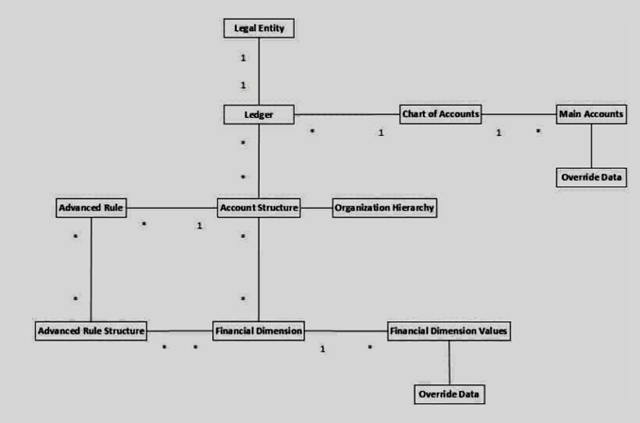The Distinction between Legal Entities and Financial Dimension in AX
Publish Date: December 26, 2017Legal Entity in AX
A Legal Entity is any Company/ Enterprise /Legal Body that is identified through registration with legal authority to do business. A company is referred as a legal entity in AX. Every legal entity record is associated with a company ID and can enter into legal contracts. They are required to prepare statements reporting their performance and have their own set of Chart of accounts, Main Accounts, and other related masters.
Financial Dimensions in AX
Financial dimensions in AX, are data classifiers, used to categorize companies and are used for a lot of purposes such as to track department information or cost center, financial reporting. Financial Dimensions provide with a more in-depth analysis of the transactions posted on general ledger accounts, where it gives the controllership an analytical view of the transactions occurred on the expenses account.

Financial Dimensions are highly flexible and are used for reconciliation purposes in inventories or projects, consolidation and mapping to external systems. Dimensions form segments in the accounting structure and are used to track and group later them in a meaningful way. From a legal perspective, there is a need to track all voucher transactions with main accounts (listed in the chart of accounts). But this might not be sufficient, and dimensions might be needed to tag every transaction. The dimensions used for each legal entity can be different and can be configured in the Ledger Setup. Financial dimensions are assigned to different entities (customers, items, orders, etc.), and are combined and posted in the general journal as appropriate.
Deeper Insight
Although Financial Dimensions can be used to represent legal entities without creating the legal entities in Microsoft Dynamics AX, financial dimensions aren’t exactly designed to address the operational or business needs of legal entities. Before setting up financial dimensions as legal entities, evaluate business processes in the following areas to determine if this setup will work for the organization or not.
- Inventory
- Sales/purchases between financial dimensions and legal entities
- Sales tax calculation and reporting
- Operational reporting
Till the version 5 (AX 2009), AX had only three fixed Financial Dimensions Namely
- Cost Centre,
- Business Unit, and
- Purpose.
The option to define unlimited Financial Dimensions was introduced In Version 6 (AX 2012).
The key differentiating factor between the two Version 5 (AX 2009) and Version 6 (AX 2012) are as below
| What Can You Do | AX 2009 | AX 2012 | Why is this important? |
|---|---|---|---|
| Add an unlimited number of Financial Dimensions. | Users could create a limited number of Financial Dimensions:
|
Users can create an unlimited number of Financial Dimensions. | Accounting tracking and reporting can be complex. |
| Create Financial Dimensions easily. | Financial Dimensions were created one at a time by using a wizard. This wizard required that the user compile and synchronize before the dimension changes took effect. | Financial Dimensions can be created by using a form. The process resembles the setup tasks for other base data. | Financial Dimensions are easier to create and use. |
| Rename default Financial Dimensions. | You could rename the default Financial Dimensions, but the process was complex and often required IT assistance. | Users can create and rename any Financial Dimension without assistance from IT. | One can easily modify the default Financial Dimensions. Customizations are not required. |
| Link Financial Dimensions to an entity. | A user could track an existing entity, like customer, vendor, or site, as a dimension. However, the user had to manually define every instance of the entity as a financial dimension value. | Users can link a Financial Dimension to an entity in the system and use the values of the entities as the financial dimension themselves. | Financial Dimensions are easy to use. |
| Define a date range for financial dimension values. | Users could not define a date range to specify when Financial Dimension values could be posted on transactions. | A date range can be entered on each Financial Dimension value. | There are more controls for date-sensitive activities. |
There are instances where Financial Dimension are linked with Legal Entities, and this is not recommended, except when the business process requires it. There are different requirements between Legal Entities as far as financial dimensions are concerned. Each Entity has a Ledger and its Account Structures, a set of rules that determine which dimensions are required and which ones are valid.
Some examples of the limitations of linking Legal entities with Financial Dimensions include:
- Sales tax functionality can be used only with legal entities and not with financial dimensions.
- Some reports don’t include financial dimensions, so you can’t always report on financial dimension unless modified.
The financial dimension framework in Microsoft Dynamics AX 2012 supports a flexible chart of accounts that meet the growing needs of organizations. It provided support to numerous financial dimensions. This included all reports, forms and data entry in which financial dimensions were supported. Prior releases were limited to 3 out of the box with an option to purchase up to seven additional financial dimensions. The other advantage was the improved experience of creating new financial dimensions, defining the rules around valid combinations and improves data entry of financial dimensions. Account structures and advanced rules were introduced in AX 2012 which determined the sequence of data entry and the rules around valid combinations of main account and financial dimension values.
Contact us today to find out more about MS Dynamics and how we can put it to work for you.
R R Bajee Ramesh- Program Manager – MS Dynamics @YASH Technologies
Image credits:
References:
community.dynamics.com/ax/f/33/t/198178
technet.microsoft.com/en-us/library/hh416704.aspx


















